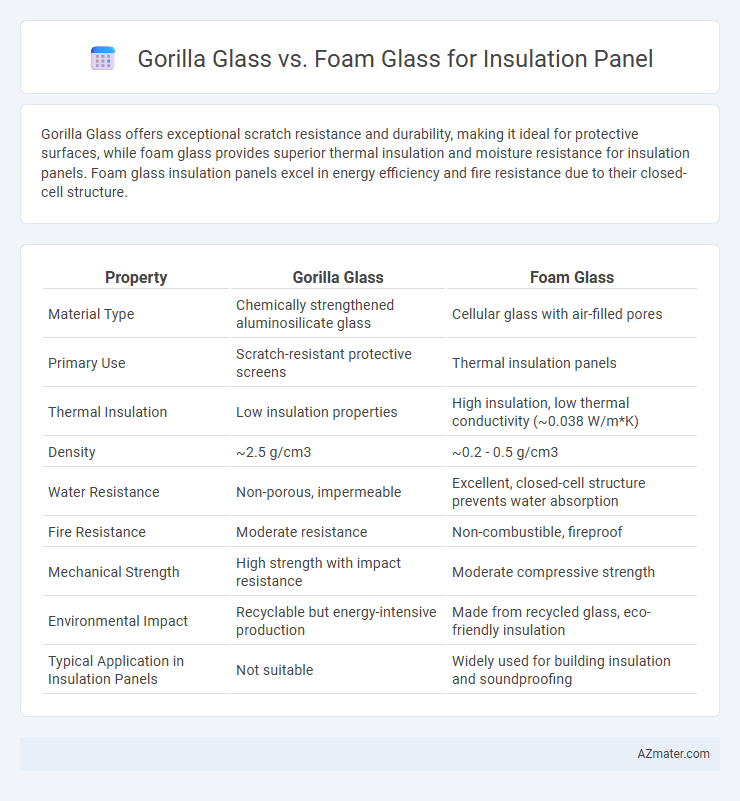Gorilla Glass offers exceptional scratch resistance and durability, making it ideal for protective surfaces, while foam glass provides superior thermal insulation and moisture resistance for insulation panels. Foam glass insulation panels excel in energy efficiency and fire resistance due to their closed-cell structure.
Table of Comparison
| Property | Gorilla Glass | Foam Glass |
|---|---|---|
| Material Type | Chemically strengthened aluminosilicate glass | Cellular glass with air-filled pores |
| Primary Use | Scratch-resistant protective screens | Thermal insulation panels |
| Thermal Insulation | Low insulation properties | High insulation, low thermal conductivity (~0.038 W/m*K) |
| Density | ~2.5 g/cm3 | ~0.2 - 0.5 g/cm3 |
| Water Resistance | Non-porous, impermeable | Excellent, closed-cell structure prevents water absorption |
| Fire Resistance | Moderate resistance | Non-combustible, fireproof |
| Mechanical Strength | High strength with impact resistance | Moderate compressive strength |
| Environmental Impact | Recyclable but energy-intensive production | Made from recycled glass, eco-friendly insulation |
| Typical Application in Insulation Panels | Not suitable | Widely used for building insulation and soundproofing |
Overview: Gorilla Glass vs. Foam Glass for Insulation Panels
Gorilla Glass, known for its exceptional strength and scratch resistance, is primarily used in applications requiring durability and transparency but offers limited thermal insulation properties. Foam glass insulation panels consist of porous, glass-ceramic material providing excellent thermal insulation, fire resistance, and moisture resistance, making them ideal for building envelope applications. Comparing both, foam glass is more effective for insulation purposes due to its low thermal conductivity and structural stability under temperature fluctuations.
Composition and Manufacturing Process
Gorilla Glass is an alkali-aluminosilicate sheet glass composed primarily of silicon dioxide, aluminum oxide, and alkali oxides, manufactured through a fusion and ion-exchange process that enhances its strength and scratch resistance. Foam glass insulation panels consist of crushed recycled glass mixed with foaming agents, heated to create a cellular, closed-cell structure that provides excellent thermal and acoustic insulation. The manufacturing of foam glass involves melting, foaming, and annealing steps, resulting in lightweight, chemically inert panels with superior compressive strength compared to conventional insulation materials.
Mechanical Strength and Durability
Gorilla Glass offers superior mechanical strength compared to foam glass, boasting high resistance to scratches, impact, and bending, making it ideal for applications requiring durability under stress. Foam glass insulation panels provide excellent compressive strength and thermal insulation but are more brittle and susceptible to cracking under heavy mechanical loads. The long-term durability of Gorilla Glass in demanding environments surpasses foam glass, especially where resistance to wear and mechanical impact is critical.
Thermal Insulation Performance
Foam glass offers superior thermal insulation performance compared to Gorilla glass, due to its closed-cell structure which minimizes heat transfer and provides excellent resistance to moisture and fire. Gorilla glass, primarily designed for durability and scratch resistance in electronic devices, lacks the necessary porosity and thermal properties required for effective insulation. Foam glass insulation panels are widely preferred in construction and industrial applications where maintaining temperature control and energy efficiency is critical.
Weight and Structural Implications
Gorilla Glass offers significant weight advantages over Foam Glass insulation panels, being thinner and lighter while maintaining high strength and durability. Foam Glass, although heavier due to its cellular structure, provides excellent compressive strength and superior thermal insulation properties. The structural implications favor Gorilla Glass for applications requiring minimal weight and high impact resistance, while Foam Glass excels in load-bearing insulation with enhanced fire resistance.
Moisture and Chemical Resistance
Gorilla Glass offers exceptional moisture resistance due to its non-porous, chemically inert surface, making it highly effective in wet or humid environments. Foam glass insulation panels also provide excellent moisture resistance as their closed-cell structure prevents water absorption and vapor penetration. Chemically, Gorilla Glass resists most acids and alkalis, while foam glass resists chemical degradation from acids, bases, and solvents, ensuring long-term durability in corrosive conditions.
Fire and Heat Resistance Capabilities
Gorilla Glass offers excellent thermal resistance with a high melting point around 650degC, making it durable under intense heat but primarily designed for impact resistance in electronic devices rather than insulation. Foam glass insulation panels provide superior fire and heat resistance, with a melting point exceeding 1000degC, non-combustible properties, and excellent thermal insulation capabilities due to their closed-cell structure. Foam glass is ideal for fireproof insulation applications in industrial settings, whereas Gorilla Glass is less suitable for direct high-temperature insulation.
Sustainability and Environmental Impact
Gorilla Glass offers high durability and scratch resistance but involves energy-intensive manufacturing processes that can increase its carbon footprint. Foam glass insulation panels, made from recycled glass, provide excellent thermal insulation with a low environmental impact due to their recyclability and reduced resource consumption. Foam glass excels in sustainability by combining long lifespan, non-toxicity, and a lower embodied energy compared to the production of Gorilla Glass.
Cost Comparison and Market Availability
Gorilla Glass insulation panels typically carry a higher cost due to their advanced chemical strengthening technology and durability, making them suitable for premium applications. Foam glass insulation panels offer a more cost-effective solution with widespread market availability, benefiting from easier manufacturing processes and abundant raw materials. While Gorilla Glass is limited to niche markets with higher budgets, foam glass enjoys broader adoption in commercial and residential insulation projects due to its competitive pricing and accessibility.
Ideal Applications and Recommendations
Gorilla Glass offers high durability and scratch resistance, making it ideal for applications requiring transparent, impact-resistant surfaces, such as smartphone screens and electronic displays. Foam glass excels in thermal insulation, moisture resistance, and fire safety, making it suitable for building envelopes, industrial insulation, and subterranean applications. For insulation panels, foam glass is recommended due to its superior insulating properties, compressive strength, and long-term stability in harsh environments.

Infographic: Gorilla glass vs Foam glass for Insulation panel
 azmater.com
azmater.com